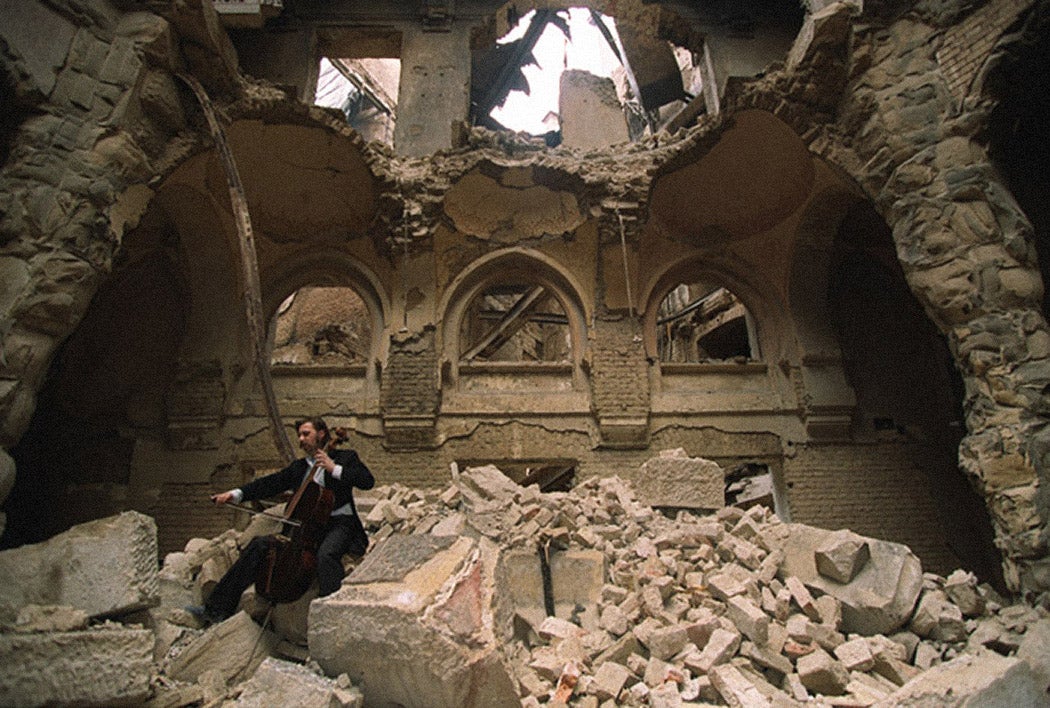The 2014 film The Monuments Men highlighted the incredible work done to protect and save significant works of art and architecture during World War II. It romanticized the great lengths that should be taken in wartime to protect objects of cultural significance. So important was western Europe’s visual cultural heritage that the Allied forces put together a special unit, the Monuments, Fine Arts, and Archives Section Unit (MFAA), to secure and recover art and architecture. However, reality is far less thorough. More recent wars, like the Bosnian War in the 1990s, have shown that not only is there a lack of protection for cultural heritage, including architecture, in times of war, this type of material heritage is more often than not a target for destruction.
New terminology emerged in the early 1990s as the need grew to talk about the continued destruction of the built environment in Bosnia and Herzegovina during the Bosnian War. The Association of Architects in Sarajevo coined the term “warchitecture” in 1993 to describe “war carried out through and as the destruction of architecture,” referring particularly to the ruinous state of Sarajevo, which was then under siege (a situation that would last until 1996).
Andrew Herscher explains that developing this new terminology allowed for a wider discourse to develop between scholarship of both war and architecture, writing that the
potential of the concept of warchitecture is to bring the interpretive protocols of architecture to bear upon architecture’s destruction. In so doing, the study of architecture can throw into question received distinctions between war and architecture, open up new ways of examining and understanding wartime violence against architecture, and connect violence against architecture to emergent discussion of war, violence, and modernity in and across other disciplines.
Why does the built environment become a target during war? Reasons vary. It can be because of a building’s function, what it houses inside, or what it represents symbolically. Regardless of the impetus, the mass destruction of architecture destroys infrastructure and greatly destabilizes life for those forced to live surrounded by ruins.
Scholars suggest that understanding the targeted destruction of architecture is necessary to understand how the Bosnian War played out. Art historian András Riedlmayer argues that
[t]hroughout Bosnia, libraries, archives, museums and cultural institutions [had] been targeted for destruction, in an attempt to eliminate the material evidence—books, documents and works of art—that could remind future generations that people of different ethnic and religious traditions once shared a common heritage in Bosnia.
In some cases, a building of cultural significance would be in ruins while neighboring structures were untouched. The burning of the National and University Library of Bosnia and Herzegovina and shelling of the Oriental Institute, both in Sarajevo, are examples of this type of pinpoint precision. Riedlmayer points out the strategy behind this cultural destruction, noting that
[b]y burning the documents, by razing mosques and Catholic churches and bulldozing the graveyards, the nationalist forces who [had] taken over these towns and villages [were] trying to insure themselves against any future claims by the people they [had] driven out and dispossessed.
Within Sarajevo, the built environment and natural landscape also shaped one’s “safety” as people tried to navigate its urban spaces during the years of the siege. Sniper Alley, which was commonly spoken of by the press during its war coverage, was a major thoroughfare through the city that was exposed to and frequently targeted by snipers. Because of Sarajevo’s layout, which stretches roughly east–west along the Miljacka River and is notably surrounded by hills (the very terrain that made the city an ideal site for the 1984 Winter Olympics), residents were forced to navigate exposed terrain despite the great risk of life in doing so.
As Mirjana Ristic explains, “[t]he configuration of Sarajevo’s topography and urban morphology together with the war in which the siege line was established enabled snipers to see a significant portion of the cityspace without being seen.”
While the destruction of architecture in times of war may be described in an objective manner, its destruction is never impersonal. As scholars have shown through their analysis of the destruction to the built environment during the Bosnian War, this type of loss has long-lasting cultural and humanitarian repercussions.
Teaching Tips
- For more on the destruction of cultural property during the Bosnian War, read Helen Walasek’s (open-access) chapter “Bosnia and the Destruction of Identity,” in Critical Perspectives on Cultural Memory and Heritage: Construction, Transformation and Destruction (2020).
- Read and discuss “A City that Doesn’t Forget: Sarajevo Thirty Years After the War,” an essay written and illustrated by Sundus Al-Bayati, the 2019 recipient of the H. Allen Brooks Travelling Fellowship from the Society of Architectural Historians.
- For the lingering effects of war on urban patterns, see “The Environmental Aesthetics of Sarajevo: A City Shaped by Memory” (2017) from the open-access journal Urbani Izziv.







